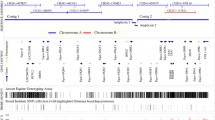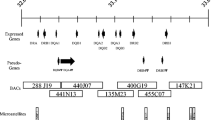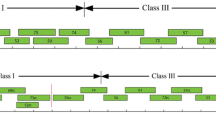Abstract
The availability of a contig of bacterial artificial chromosome (BAC) clones spanning the equine major histocompatibility complex (MHC) made possible a detailed analysis of horse MHC class I genes. Prior to this study, only a single horse MHC class I gene had been sequenced at the genomic level. Although many (∼60) MHC class I cDNA sequences had been determined and published, from this information, it was not possible to determine how many class I loci are expressed in horses or to assign individual sequences to allelic series. In this study, 15 MHC class I genes were identified in BAC subclones and fully sequenced. Because the BAC library donor horse had been bred for homozygosity at the MHC, these 15 genomic clones represent distinct MHC class I genes and pseudogenes and not alleles at a smaller number of loci. For five of the genes, cDNA sequences from these loci had previously been identified. Two additional expressed class I genes were discovered, bringing the known total of different equine MHC class I genes (loci) expressed as mRNA to seven. Expression of all seven loci was detected by reverse transcriptase–polymerase chain reaction in adult, fetal, and placental tissues. The remaining eight genes were designated as pseudogenes. This work resulted in moderate expansion of the horse MHC BAC contig length, and the remaining gap was shortened. The information contained in these equine MHC class I sequences will permit comparison of MHC class I genes expressed across different horse MHC haplotypes and between horses and other mammalian species.




Similar content being viewed by others
References
Alexander AJ, Bailey E, Woodward JG (1987) Analysis of the equine lymphocyte antigen system by Southern blot hybridization. Immunogenetics 25(1):47–54
Ansari HA, Hediger R, Fries R, Stranzinger G (1988) Chromosomal localization of the major histocompatibility complex of the horse (ELA) by in situ hybridization. Immunogenetics 28(5):362–364
Antczak DF, Bright SM, Remick LH, Bauman BE (1982) Lymphocyte alloantigens of the horse. I. Serologic and genetic studies. Tissue Antigens 20(3):172–187
Bacon SJ, Ellis SA, Antczak DF (2002) Control of expression of major histocompatibility complex genes in horse trophoblast. Biol Reprod 66(6):1612–1620
Barbis DP, Maher JK, Stanek J, Klaunberg BA, Antczak DF (1994) Horse cDNA clones encoding two MHC class I genes. Immunogenetics 40(2):163
Carpenter S, Baker JM, Bacon SJ, Hopman T, Maher J, Ellis SA, Antczak DF (2001) Molecular and functional characterization of genes encoding horse MHC class I antigens. Immunogenetics 53(9):802–809
Cereb N, Yang SY (1994) The regulatory complex of HLA class I promoters exhibits locus-specific conservation with limited allelic variation. J Immunol 152(8):3873–3883
Cereb N, Maye P, Lee S, Kong Y, Yang SY (1995) Locus-specific amplification of HLA class I genes from genomic DNA: locus-specific sequences in the first and third introns of HLA-A, -B, and -C alleles. Tissue Antigens 45(1):1–11
Chung C, Leib SR, Fraser DG, Ellis SA, McGuire TC (2003) Novel classical MHC class I alleles identified in horses by sequencing clones of reverse transcription–PCR products. Eur J Immunogenet 30(6):387–396
Crew MD, Phanavanh B, Garcia-Borges CN (2004) Sequence and mRNA expression of nonclassical SLA class I genes SLA-7 and SLA-8. Immunogenetics 56(2):111–114
David-Watine B, Logeat F, Israel A, Kourilsky P (1990) Regulatory elements involved in the liver-specific expression of the mouse MHC class I Q10 gene: characterization of a new TATA-binding factor. Int Immunol 2(10):981–993
Daza-Vamenta R, Glusman G, Rowen L, Guthrie B, Geraghty DE (2004) Genetic divergence of the rhesus macaque major histocompatibility complex. Genome Res 14(8):1501–1515
Donaldson WL, Zhang CH, Oriol JG, Antczak DF (1990) Invasive equine trophoblast expresses conventional class I major histocompatibility complex antigens. Development 110(1):63–71
Drezen JM, Cohen-Tannoudji M, Pournin S, Babinet C, Morello D (1995) Developmental expression of H-2K major histocompatibility complex class I transgenes requires the presence of proximal introns. Dev Dyn 204(1):98–105
Ellis SA, Martin AJ, Holmes EC, Morrison WI (1995) At least four MHC class I genes are transcribed in the horse: phylogenetic analysis suggests an unusual evolutionary history for the MHC in this species. Eur J Immunogenet 22(3):249–260
Ellis SA, Holmes EC, Staines KA, Smith KB, Stear MJ, McKeever DJ, MacHugh ND, Morrison WI (1999) Variation in the number of expressed MHC genes in different cattle class I haplotypes. Immunogenetics 50(5–6):319–328
Germain RN, Margulies DH (1993) The biochemistry and cell biology of antigen processing and presentation. Annu Rev Immunol 11:403–450
Gobin SJ, van den Elsen PJ (1999) The regulation of HLA class I expression: is HLA-G the odd one out? Semin Cancer Biol 9(1):55–59
Guerin G, Bertaud M, Chardon P, Geffrotin C, Vaiman M, Cohen D (1987) Molecular genetic analysis of the major histocompatibility complex in an ELA typed horse family. Anim Genet 18(4):323–336
Gustafson AL, Tallmadge RL, Ramlachan N, Miller D, Bird H, Antczak DF, Raudsepp T, Chowdhary BP, Skow LC (2003) An ordered BAC contig map of the equine major histocompatibility complex. Cytogenet Genome Res 102(1–4):189–195
Holmes EC, Ellis SA (1999) Evolutionary history of MHC class I genes in the mammalian order Perissodactyla. J Mol Evol 49(3):316–324
Howcroft TK, Raval A, Weissman JD, Gegonne A, Singer DS (2003) Distinct transcriptional pathways regulate basal and activated major histocompatibility complex class I expression. Mol Cell Biol 23(10):3377–3391
Koller BH, Sidwell B, DeMars R, Orr HT (1984) Isolation of HLA locus-specific DNA probes from the 3′-untranslated region. Proc Natl Acad Sci U S A 81(16):5175–5178
Kulski JK, Gaudieri S, Dawkins RL (2000) Using alu J elements as molecular clocks to trace the evolutionary relationships between duplicated HLA class I genomic segments. J Mol Evol 50(6):510–519
Kulski JK, Shiina T, Anzai T, Kohara S, Inoko H (2002) Comparative genomic analysis of the MHC: the evolution of class I duplication blocks, diversity and complexity from shark to man. Immunol Rev 190:95–122
Lanier LL (1997) Natural killer cell receptors and MHC class I interactions. Curr Opin Immunol 9(1):126–131
Lazary S, Antczak DF, Bailey E, Bell TK, Bernoco D, Byrns G, McClure JJ (1988) Joint Report of the Fifth International Workshop on Lymphocyte Alloantigens of the Horse, Baton Rouge, Louisiana, 31 October–1 November 1987. Anim Genet 19(4):447–456
Lear TL, Breen M, Ponce de Leon FA, Coogle L, Ferguson EM, Chambers TM, Bailey E (1998) Cloning and chromosomal localization of MX1 and ETS2 to chromosome 26 of the horse (Equus caballus). Chromosome Res 6(4):333–335
Lew AM, Bailey E, Valas RB, Coligan J (1986) The gene encoding the equine soluble class I molecule is linked to the horse MHC. Immunogenetics 24(2):128–130
Mavria G, Hall KT, Jones RA, Blair GE (1998) Transcriptional regulation of MHC class I gene expression in rat oligodendrocytes. Biochem J 330(Pt 1):155–161
McGuire TC, Leib SR, Mealey RH, Fraser DG, Prieur DJ (2003) Presentation and binding affinity of equine infectious anemia virus CTL envelope and matrix protein epitopes by an expressed equine classical MHC class I molecule. J Immunol 171(4):1984–1993
Moore KW, Sher BT, Sun YH, Eakle KA, Hood L (1982) DNA sequence of a gene encoding a BALB/c mouse Ld transplantation antigen. Science 215(4533):679–682
Parham P, Lawlor DA, Lomen CE, Ennis PD (1989) Diversity and diversification of HLA-A, B, C alleles. J Immunol 142(11):3937–3950
Pullen JK, Horton RM, Cai ZL, Pease LR (1992) Structural diversity of the classical H-2 genes: K, D, and L. J Immunol 148(3):953–967
Shawar SM, Vyas JM, Rodgers JR, Rich RR (1994) Antigen presentation by major histocompatibility complex class I-B molecules. Annu Rev Immunol 12:839–880
Steinmetz M, Moore KW, Frelinger JG, Sher BT, Shen FW, Boyse EA, Hood L (1981) A pseudogene homologous to mouse transplantation antigens: transplantation antigens are encoded by eight exons that correlate with protein domains. Cell 25(3):683–692
Takahata N (1995) MHC diversity and selection. Immunol Rev 143:225–247
Tallmadge RL, Lear TL, Johnson AK, Guerin G, Millon LV, Carpenter SL, Antczak DF (2003) Characterization of the beta2-microglobulin gene of the horse. Immunogenetics 54(10):725–733
Ungchusri T, Chiang EY, Brown G, Chen M, Tabaczewski P, Timares L, Stroynowski I (2001) Widespread expression of the nonclassical class I Qa-2 antigens in hemopoietic and nonhemopoietic cells. Immunogenetics 53(6):455–467
Vaiman M, Chardon P, Cohen D (1986) DNA polymorphism in the major histocompatibility complex of man and various farm animals. Anim Genet 17(2):113–133
van den Elsen PJ, Holling TM, Kuipers HF, van der Stoep N (2004) Transcriptional regulation of antigen presentation. Curr Opin Immunol 16(1):67–75
Velten FW, Renard C, Rogel-Gaillard C, Vaiman M, Chardon P (1999) Spatial arrangement of pig MHC class I sequences. Immunogenetics 49(11–12):919–930
Wroblewski JM, Kaminsky SG, Nakamura I (1994) Bat-1 genes and the origin of multiple class I loci in the H-2D region. Immunogenetics 39(4):276–280
Zijlstra M, Bix M, Simister NE, Loring JM, Raulet DH, Jaenisch R (1990) Beta 2-microglobulin deficient mice lack CD4-8+cytolytic T cells. Nature 344(6268):742–746
Acknowledgements
This research was funded by NIH grants HD-34086, HD-15799, and HD-049545, the Harry M. Zweig Memorial Fund for Equine Research, the Dorothy Russell Havemeyer Foundation, Inc., the USDA Regional Grant Program, and the Morris Animal Foundation. This manuscript is published in connection with a project of the University of Kentucky Agricultural Experiment Station as paper number 05-14-076. The authors thank Judy Lundquist (Kentucky) for technical assistance, and Don Miller and Bettina Wagner (Cornell) for helpful discussion and assistance. All experiments described in this manuscript comply with current laws of the USA.
Author information
Authors and Affiliations
Corresponding author
Additional information
The nucleotide sequence data reported are available in the GenBank database under the accession numbers CZ552047–CZ552159, CZ559424–CZ559456, and DQ083407–DQ083421
Rights and permissions
About this article
Cite this article
Tallmadge, R.L., Lear, T.L. & Antczak, D.F. Genomic characterization of MHC class I genes of the horse. Immunogenetics 57, 763–774 (2005). https://doi.org/10.1007/s00251-005-0034-9
Received:
Accepted:
Published:
Issue Date:
DOI: https://doi.org/10.1007/s00251-005-0034-9




